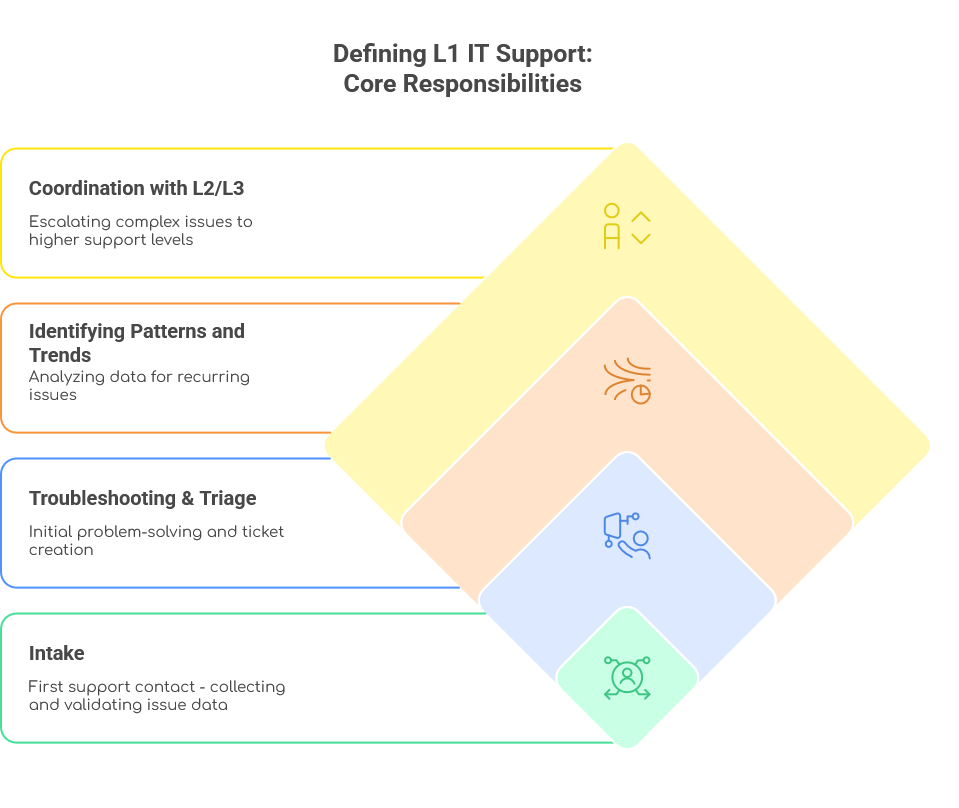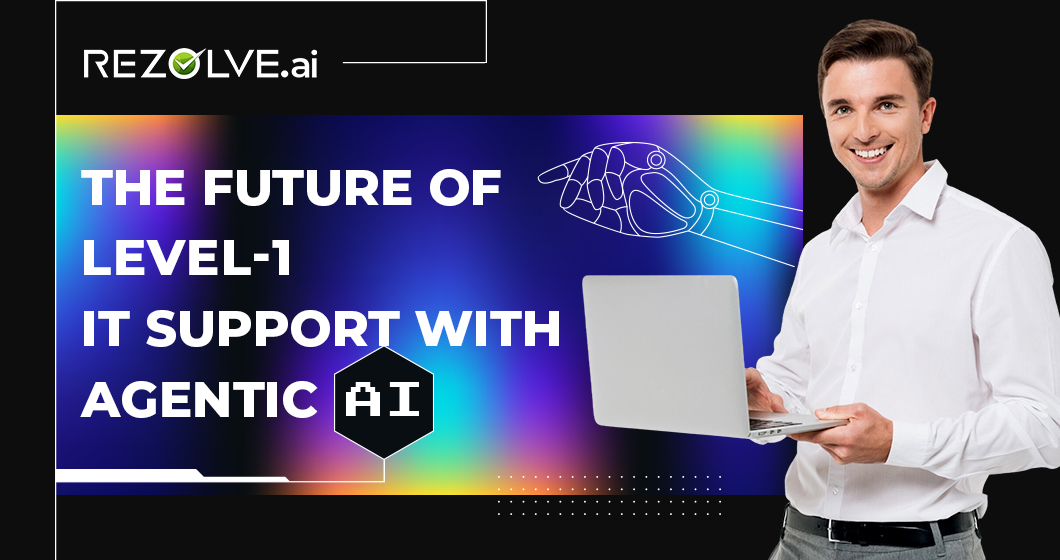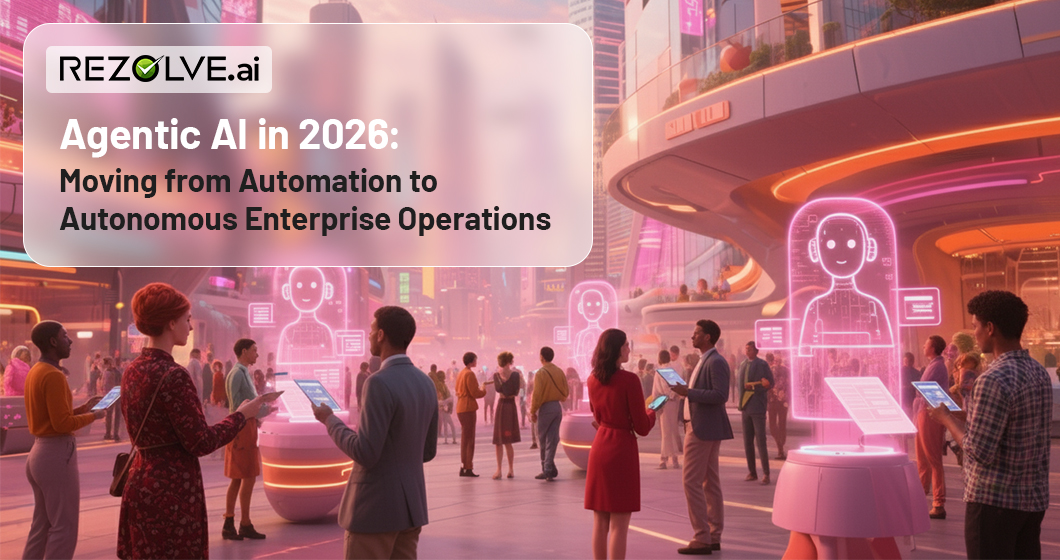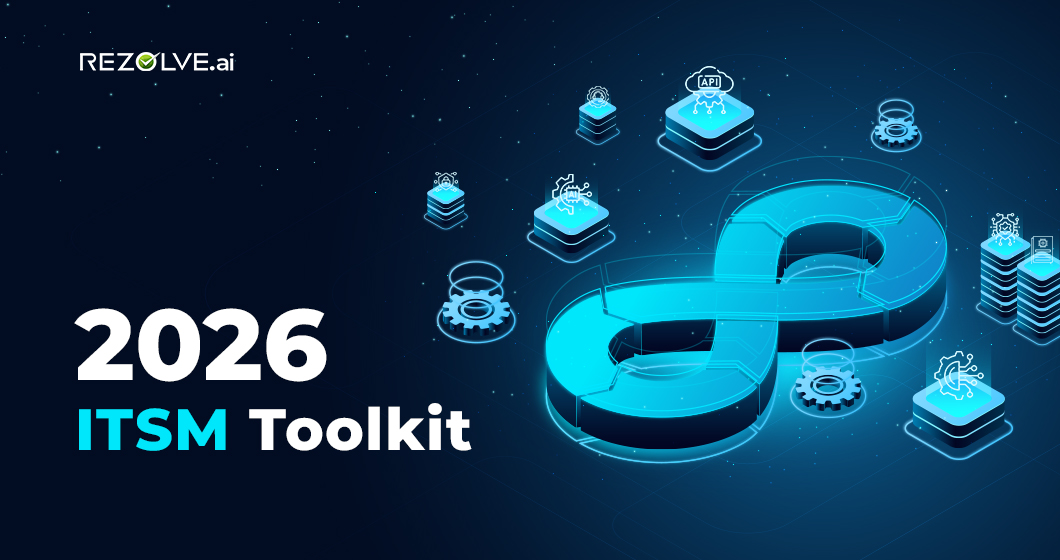For decades, Level 1 (L1) IT support has operated as the frontline of enterprise service desks—answering calls, resetting passwords, triaging tickets, and escalating issues when scripts fail. But ask any IT leader, and they’ll tell you the same story: L1 is a paradox. It’s indispensable yet inefficient. Mission-critical yet misunderstood.
We’re entering an era where the traditional role of L1 can be completely automated through AI, and this has huge implications for how support is structured, and how higher-level human IT support learns and functions.
What is L1 Support in IT?
L1 teams are the first responders of IT. They handle repetitive, high-volume tasks: password resets, basic troubleshooting, ticket routing, and initial diagnostics. When a server crashes at midnight or a CEO forgets their credentials before a board meeting, L1 technicians (or their chatbots) are the first to engage. Their role isn’t merely technical, but also social. They absorb user frustration, decode vague complaints (“My Excel is broken!”), and maintain order in chaos. Historically, L1 has also been a talent pipeline — a place for junior staff to cut their teeth before advancing to L2/L3 roles.

L1 support has always been a pressure cooker. Capacity planning nightmares (think post-holiday password reset requests), inconsistent training, and the cumbersome task of maintaining outdated knowledge bases plagued most large ITSM teams (typically L1 support may constitute 30% to 50% of overall hours spent in a service desk). For 20 years or so, organizations have tried to automate L1 with solutions which fell short of full automation: clunky chatbots, self-service portals, and “shift-left” strategies.
Chatbots: From Rules-Based Engines to Probabilistic Agents
Watch in Action: See how Agentic AI is redefining Level-1 IT support. Watch the demo -
Early chatbots were basically if-then decision trees, sometimes with a layer of natural language understanding to try to match whatever a user asked for with a pre-written self-service option. To be fair, self-service does deflect tickets, and providing more channels to access self-service can yield some lift, but it always fell far short of human support. Also, past self-service initiatives often did not get the adoption level within user communities necessary for success. Therefore, L1 teams remained essential and with their work largely unchanged by the new technology.
Then generative AI hit the scene at the end of 2022. No longer bound by decision rules, this new form of AI functioned on probability, and was designed to mimic human communication for virtually any topic. Suddenly, these chatbot systems understood questions in the same way a human technician would. They would stitch together answers from three knowledge bases and a PDF. Progress? Yes, and wildly impressive progress at that – but they still couldn’t act. Essentially, generative AI bots had better access to knowledge and could make better cognitive sense of it to put out a logical response, but they had no real ‘agency.’ They were hobbled by their inability to do anything beyond providing information. If a user asked, “Why is the VPN broken?”, the AI would shrug (metaphorically) and provide common reasons a VPN might be down, and perhaps steps to help self-diagnose, or escalate (if it was given that capability). It was reactive, polite, and limited.
Enter agentic AI. Agentic AI refers to generative AI solutions which have technical scaffolding built around them to enable them to take actions on the desktop, web, or other applications, and to plan and execute multi-step tasks over increasingly long-time horizons. Unlike rules-based systems or even GenAI chatbots, agentic AI doesn’t just answer questions—it can solve them. It’s the difference between a chatbot telling a user where to go to reset a password, and an AI agent verifying identity via Okta, executing the reset, and notifying the user—all in less time than it would take a human technician to decide what to get for lunch. When properly integrated with a technical environment, this functionality can extend as far as diagnosing a server outage, triggering protocols for major incidents, routing tickets, looping in technicians when required, and orchestrating complex IT and employee support processes. Agentic AI absorbs L1’s grunt work while redefining what is possible. This isn’t an incremental improvement but truly a paradigm shift.
This kind of solution is already live and yielding real ROI – MyEyeDr, a subsidiary of Goldman Sachs, saw its resolution times for some support tasks fall from an average of 4 days to less than 10 minutes, saving time, money, and user frustration.
What are the limitations?
Agentic AI can legitimately feel like magic, but it’s not – getting results requires foundational work, and AI agents don’t function the same way human employees do:
- AI agents in the ITSM space can currently only act on systems they’re integrated with – an imperfect metaphor is that the AI agent is a switchboard operator: they’re smart enough to figure out what switch to flip to meet the user’s need, but they’re limited to the switches given to them. Creating those switches usually means deliberate API work in multiple systems, creating modular services, and development of small connective automations. As a side note, cutting edge AI agents aren’t completely limited to their metaphorical switchboards, but in the context of IT support, the risk of an unconstrained agent accidentally deleting a key database or making some other costly mistake means that most vendors and enterprises are strictly predetermining the actions they can take.
- AI agents learn differently than humans do. If an employee calls a human IT technician about an update to Outlook which is causing internal emails to be flagged as spam, and IT didn’t already know about it, the technician updates their understanding. When the next employee calls about the same issue, the technician recognizes it, has figured out what action to take or response to give, and addresses the call more efficiently. AI agents largely aren’t set up to instantly learn from the conversations they have. They intentionally drop a conversation context once the ticket/session is done, only “remembering” once enabled to by an update in the back end (e.g., finetuning run, update to system prompt or reference database – there are several mechanisms). As a result, by default, AI agents treat every instance of an issue the same way, potentially creating redundant tickets until updated. Modern ITSM solutions have a number of automatic mitigations for this – for example, pattern recognition and clustering engines to merge duplicates and identify incidents, smart retraining triggers, and knowledge snippet creation scripts.
Right now, most of these AI agents are text only - most aren’t set up to field voice calls from frantic executives who need their laptop to work for a presentation in 20 minutes. However, this will resolve itself - the technical limitations of working through voice channels are minimal, and omnichannel support agents will become the norm in a matter of months. With that said, there will likely remain some edge cases, like the executive emergency example, where organizations will still have human technicians for support as a matter of preference.
To provide a grounded perspective of the current state, enterprises implementing basic versions of these solutions (knowledge support, agentic troubleshooting and triaging, automated routing of smart tickets, automation of simple tasks and access issues, etc.) are usually seeing around 35% deflection of all tickets – L1, L2, L3+, and can see up to 75% deflection of L1. More advanced implementations which incorporate capabilities like process automation of common workflows, and which integrate with a wider array of enterprise applications can reach up to 60-70% deflection for all tickets, and 90% for L1.
Due to the limitations mentioned above, foremost among them adequately capable voice bots, L1 can’t be completely deflected today, at least not without a very simple problem environment or user-unfriendly channel restriction. However, with ever-improving voice AI getting added into the mix, 100% L1 automation is increasingly feasible. With that said, most businesses will prefer not to automate that last 10-20%; when people (especially executives) have urgent or sensitive issues, they don’t want to wait for escalation or waste time with a system which may not be able to quickly understand their needs. Humans remain much more adaptable than even the best AI systems, and most businesses will choose to structure their support as a hybrid, at least in the short term.
.png)
Why Does This Matter Now?
The inefficiency of traditional L1 is colliding with modern demands. Users expect instant resolutions. Businesses can’t afford downtime. Talent has less tolerance for monotonous work. As technology improves, expectations rise, and the service levels afforded by the ITSM systems of decades past become table stakes.
Agentic AI offers the potential to realize the long-sought-after dream of fully automating L1. All of the core responsibilities outlined earlier - intake, troubleshooting and triage, identifying patterns, and coordinating with higher level support – are feasible to automate through agentic AI. There will be a transition period as remaining exception cases within L1 are handled or designated for L2, but the ITSM teams of the near future will typically be comprised of new roles like AI supervisors, workflow managers, and specialist agents, whose responsibilities center around auditing decisions, tackling edge cases that require human intervention, and monitoring and optimizing the overall system. The era of “foundational” support is ending. What’s emerging is a hybrid model where AI performs most of the work with humans providing oversight and handling exceptions, and together, they deliver support that’s faster, smarter, and seamless. Traditionally structured L1 support, as we know it, will cease to exist.
What Happens to L1 Employees?
Naturally, this sparks concern about job loss – what do the displaced technicians do? Surveys of financial institutions which have completed automation projects (of many kinds, from RPA to AI to ITSM) suggest that few businesses actually lay off employees as a result. Rather, they typically repurpose those resources, enabling growth without expanding headcount. It’s also rare for an automation system to be able to do 100% of an individual’s job – in those cases, automation is usually welcomed because it’s freeing employees from the repetitive everyday tasks that they like least, freeing them up for more strategic and creative work.
As human L1 support shrinks, IT teams will adopt new roles suited for AI-powered workflows. The talent pool can redirect their energy from mindless ticket queues to overseeing AI agents, refining responses, and tackling the 10% of edge cases where creativity trumps code (L2/L3).
The IT Support Talent Pipeline is Being Disrupted
L1 support has always been a launchpad. New hires waded through tickets, learned the ropes, and (if they were the right mix of skilled and lucky) graduated to the L2/L3 support band. But if AI handles the grunt work, what’s left? Two paths will most likely emerge:
- The AI Managers: These folks refine the AI and integrated systems. They train models, audit decisions, and work to expand and optimize the system.
- The Hybrid Strategists: Half coder, half empath. They navigate the messy, human-centric issues AI can’t touch - like reassuring a frustrated exec whose Zoom crashed mid-presentation, while leveraging AI agents to automate the fix in the background.
Modern enterprises need critical thinkers rather than script followers. But there’s a skills gap in the short-term future. Gartner has already stated that 80% of the engineering workforce will need upskilling through 2027 to work with Generative AI. The fix? Partnering with learning and development platforms or building in-house “AI Labs”, enabling teams to play and iterate with tools, function as effective overseers, and hone soft skills.

Humans and AI will Co-Create Value for L2 Support
The L2 support layer has traditionally been where magic happens. Here, AI is amplifying human workers’ capabilities to create more value. Picture this: an L2 tech gets a ticket flagged as “server latency.” Instead of digging through logs, the AI serves up a diagnostic summary: “CPU spikes at 2pm daily. Root cause: Backup script conflicts with CRM sync.” The tech approves the AI’s suggested fix, deploys it, and moves to the next priority. But keep in mind that the AI doesn’t handle the CFO’s urgent call about a breached spreadsheet, or the panic of a developer whose code just disrupted a production database. AI is more adaptable than ever but still falls far short of human ability to thrive in chaos. Partnership enables the best of both worlds.
AI coding solutions like Cursor or GitHub Copilot are bellwethers for the future of work. Human developers perform a mixture of delegation, review, testing, and high-level planning and integration of newly created code. IT support is the same. Agentic AI thinks, decides and acts, while humans curate and oversee. This is a co-creation of value in the business functions that have historically been complex, slow, and costly.
Balancing Autonomy with Accountability
Deploying agentic AI isn’t a “set it and forget it” play. You’re implementing systems that can access sensitive data and execute actions with tangible outcomes. In this environment, accountability will be foundational. Enterprises looking to integrate AI agents will need:
- Audit trails with surgical precision: Every decision, every action, timestamped and traceable.
- Ethical frameworks: Bias evaluation for sensitive use cases, transparency standards, and emergency overrides.
- Human-AI feedback loops: Regular reviews of AI decisions, not micromanage, but to mentor and optimize the system.
Cultural adoption is a key hurdle which is often neglected in implementation. Good change management - conducting training, messaging consistently, and setting expectations with both your team and end users prior to launch - is essential to getting the most out of your systems. Starting small with a pilot project and a sandbox environment is best practice for less experienced enterprises. Let the AI handle low-stakes tasks, demonstrate its value, and then scale thoughtfully.
The Bleeding Edge of ITSM: Custom Multi-Agent Systems
The largest and most innovative enterprises are taking ITSM automation with agentic AI even farther. Such enterprises are setting up custom technical scaffolding comprised of multiple agents specialized in particular tasks, connected by workflows and business rules, some of which are written and adapted on demand by a planning agent. One example of this is research agents, like the “Deep Research” models of most of the frontier AI labs. Enterprises are using these kinds of multi-agent systems to accomplish feats like automatically detecting a zero-day exploit, generating a patch, testing it in a sandbox, and then deploying it globally, all in a matter of minutes.
The Reality of ROI in this Arena
Agentic AI reduces costs but conceptualizing it purely as a cost play is incomplete. The biggest value for enterprises here is resilience, speed and efficiency - AI doesn’t sleep. It doesn’t take vacations. It scales massively. During a cyberattack, while your team is swarming, the team of AI agents will already be isolating compromised nodes, revoking credentials, and alerting stakeholders. For instance, Rezolve.ai consists of 7-agent AI architecture. This includes ticket creation agent, human escalation and live chat agent, data leak prevention agent, automation agent, knowledge and enterprise search agent, ticket insight agent, troubleshooting and triaging agent. All these agents talk to each other within the dynamic IT ticketing environment – and respond aptly as and when the time comes with each agent executing its function precisely.
That’s not only cost savings, but highly valuable organizational armor. That kind of armor is necessary in tomorrow's threat environment – agentic AI is also rapidly improving the capabilities of malicious actors to conduct offensive cyberattacks and personalized phishing.
Surviving and Thriving with AI is Not Optional
The message is clear for businesses: clinging to legacy L1 support and traditional ITSM models risks losing agility, talent, and user trust. The clear winners will be those embracing agentic AI as a collaborator, integrating it deeply into their everyday workflows, in the same way we use spellcheck, GPS, or Google, or Excel today. Users won’t dread the headache of calling IT; they’ll feel secure in the knowledge that solutions to their problems will be convenient, expeditious, and usually autonomous.
Agentic AI is already demonstrating its bottomless potential for business use cases. It’s in your Microsoft Teams instances, your Slack channels, your ticketing systems, and your code repositories. The question isn’t if you’ll adopt it, but how well you’ll integrate it. Will you cling to workflows built for the pre-AI era? Or redesign your organization around a simple truth: that the best IT support isn’t human or machine, but the synergy of both?
As ever, eras of massive change make and break companies, and businesses can’t afford to be complacent.
See how Rezolve.ai’s multi-agent, action-enabled platform is helping enterprises reinvent ITSM from the ground up - See Agentic AI in Action





.webp)




.jpg)

.png)








.png)